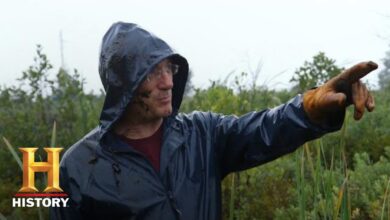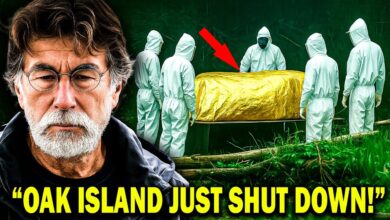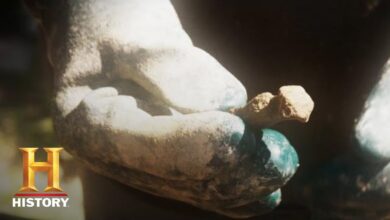The Curse of Oak Island: Astonishing 18th Century Discovery On Lot 5 (Season 10)
The Curse of Oak Island: Astonishing 18th Century Discovery On Lot 5 (Season 10)

GARY DRAYTON: I got high hopes for today.
There is a sea of flags.
How many are in there?
There are 42 flags, mate.
Really?
Yeah.
NARRATOR: Rick has joined up with metal detection expert Gary Drayton on Lot 5, located near the middle of Oak Island.
RICK LAGINA: Those flags, to me, say one thing.
Let’s go find some stuff.
- OK, mate.
You lead.
NARRATOR: After purchasing Lot 5 just two weeks ago, Rick, Marty, Craig and the team had already made a number of incredible discoveries, including tools and a musket ball that may predate the 16th century.
However, they also found a hand-forged half coin that could be one of the oldest ones ever made on Oak Island.
OK.
Here’s the first flag, mate.
[beeping]
RICK LAGINA: Ooh, those sound good.
Well, we’ll see what it is.
Just there, mate, that depression.
NARRATOR: Having already flagged a number of metal targets earlier this morning, Gary Drayton has now received permission from archaeologist Laird Niven to dig them up.
I don’t want to dig too, too aggressive.
That is crazy deep.
I’ll try pinpointing it and then grabbing it out of there.
[beeping]
That is a little screamer of a signal.
There it is.
There we go.
What the heck is that?
It’s thick and heavy.
You know what that is?
Nope.
By the look of it, this looks like some kind of blade-like tool.
This has got all the characteristics of being something really old.
NARRATOR: Another potentially ancient tool?
Is it possible that Gary and Rick have found more evidence that people were conducting an operation on Lot 5 long before the discovery of the money pit?
GARY DRAYTON: OK, we’ll bag it.
NARRATOR: If so, who was it?
And what were they doing in the middle of Oak Island?
If it’s a tool, why is it that deep?
That makes no sense.
Exactly, yeah.
Perfect candidate for an XRF.
Yeah.
It’s going to be exciting finding out what it is.
OK, mate.
Let’s get to the next flag.
OK.
GARY DRAYTON: Now I’m getting another target.
[beeping]
Let me see if I can pinpoint it.
[beeping]
No.
We’re not far away.
It’s somewhere in here.
It’s in this little area here.
Yeah, deeper down.
Got it.
[suspenseful music]
It’s in my hand.
All right.
What is it?
GARY DRAYTON: It’s in there somewhere.
Ooh.
Is it pottery?
GARY DRAYTON: I think it might be.
If it’s pottery, it’s a– a weird design.
RICK LAGINA: It’s pottery, glazed.
Brilliant.
Oh, my goodness.
We’ve never seen that before.
No.
Way the hell down there.
- Yeah.
MARTY LAGINA: Maybe you should look around in there for more pottery.
I’ll take a look.
There actually is.
All right.
Oh, my, bigger pieces.
But look how degraded it is.
GARY DRAYTON: Yeah, it is.
Isn’t it?
It’s not the same as that other piece.
There’s more, too.
MARTY LAGINA: Keep digging, Rick.
Actually, there’s quite a bit more.
Wow.
That’s some nice pieces of pottery, isn’t it?
And this looks like fine stuff.
Wow.
This is beautiful.
MARTY LAGINA: I want to know right away how old that is.
Yeah.
Yeah, I think we should stop.
Let’s get Laird over here.
Yep.
That’s a great idea.
MARTY LAGINA: And there’s the expert.
LAIRD NIVEN: What an interesting spot.
Oh, my heavens.
NARRATOR: On Lot 5, located on the western side of Oak Island, archaeologists Laird Niven and Helen Sheldon, along with Craig Tester, join Rick, Marty, and Gary Drayton to inspect a number of potentially important discoveries.
GARY DRAYTON: Got a lot of iron, but now we’ve got some fantastic pottery out of there.
MARTY LAGINA: Yeah, yeah.
GARY DRAYTON: And I don’t think we’ve seen this style of pottery before.
See what you come up with.
[suspenseful music]
HELEN SHELDON: That looks like– there’s a series of standard designs.
You can actually date the designs.
These, definitely, because of the decoration–
MARTY LAGINA: OK.
HELEN SHELDON: That’s called press molded.
And this sort of press molding started in 1740.
Well, that’s good.
HELEN SHELDON: Yeah.
The type of ceramic itself is 1720.
Wow.
Early 1700s.
- That’s pretty cool.
- Yeah.
It’s English.
GARY DRAYTON: Oh, it’s English?
Yeah.
GARY DRAYTON: Could the British military have this type of pottery, as well? - Oh, yeah.
Sure.
It was common.
Yeah.
NARRATOR: 18th century English pottery dating back more than 50 years prior to the discovery of the money pit?
Because the team has previously found evidence of an 18th century British military operation on Oak Island, could it offer more evidence that someone of English origin was connected to the 228-year-old mystery?
Or were they looking for something that had been buried here centuries earlier?
Is this type of pottery a sign of wealth or no?
It wasn’t the cheapest pottery– pottery around.
No, because of the decoration on it.
LAIRD NIVEN: Yeah.
It was highly decorated.
Yeah.
I mean, you are interested in taking a further look, aren’t you?
- Yeah.
[laughs]
MARTY LAGINA: That’s what I thought.
We stopped in order to allow you to do your work.
RICK LAGINA: I think we can find an edge.
With all those rocks, a small–
You need room to work.
A small unit’s not going to work.
GARY DRAYTON: It could be actually anything down there.
Because it– I’m using a surface metal detector, and that’s fairly deep.
Well, OK.
We’ll turn this one over to the archaeologist.
Introducing Miriam to Lot 5.
Cool.
NARRATOR: On Lot 5, archaeologists Laird Niven and Helen Sheldon welcome their colleague, Miriam Amirault, back to the island.
LAIRD NIVEN: So how are things going?
Good.
NARRATOR: She has come to assist the investigation of an area where a number of 18th century British artifacts, which predate the discovery of the money pit by half a century or more, were discovered just one day ago.
So it’s looking like we have a rock-filled excavation of some sort.
LAIRD NIVEN: Yeah.
And all the artifacts are being fairly early.
Like, there’s no mixing of modern in with them.
LAIRD NIVEN: So that’s good.
Yeah.
This is really interesting.
Yeah.
NARRATOR: A rock-filled feature– one pre-dating the discovery of the money pit?
If so, what was its purpose?
And what else might it contain?
We’re just getting a hint right now, with the artifacts and the rocks, that perhaps we’re into something substantial and important.
Still going down.
We haven’t reached the bottom yet.
So maybe if Miriam could jump in there and–
Sure.
–work on that side, and I’ll keep going here.
- Mm-hmm.
- OK.
And then maybe Laird could screen for us.
LAIRD NIVEN: I will screen.
Yup.
Yeah, sounds good.
I think I may have something here.
Just let me get it out.
[suspenseful music]
Hmm.
We’ve never found this before.
I mean, it looks blue and white, tin glazed.
That’s old.
It is old.
That’s delicate stuff.
We have to be really careful.
Wow.
Called Delftware.
I’m not sure what the starting date for that.
It’s certainly mid-1700s, so it would be English.
HELEN SHELDON: Nice. - Yeah.
So that’s a first for the island.
We’ve never found tin glazed before.
So two ceramic types have come out of here that we’ve never seen anywhere else on the island.
Two early ceramic types.
Yeah, two early ceramic types.
Nice.
Very nice. - That’s really awesome.
- Yeah.
Yeah.
Put that in the bag gently.
LAIRD NIVEN: The really bizarre thing, to me, is that this is a lot we know nothing about.
We certainly know of no occupation in the 1790s.
And all of a sudden, we’re transported back to the middle of the 1700s.
So it changes the game completely, as far as I’m concerned.
Wow.
Look at this.
LAIRD NIVEN: Ooh.
Oh, wow.
HELEN SHELDON: Look at that.
LAIRD NIVEN: That’s not something we find every day.
HELEN SHELDON: No, it isn’t.
It’s copper.
It’s a copper nail. ‘Cause look at all the green.
Right? ‘Cause iron nails go rusty, so you get the rust deposits on them.
LAIRD NIVEN: It’s pretty heavy duty, and it’s really squat.
Yeah.
Feel it. it’s got heft to it, too.
Yeah.
Look at a rose head.
It’ll be nice to clean that up.
It’s hand-forged.
HELEN SHELDON: Yeah, which kind of suggests boat building–
Yeah.
–with copper nails.
LAIRD NIVEN: ‘Cause it– it resists corrosion.
Yeah, and salt water.
NARRATOR: Over the past decade, the Oak Island team has unearthed a number of ship-related artifacts, such as wood fragments and the decking spikes in the swamp that have ranged from as late as the 18th century to as early as the 3rd century AD.
Could this copper nail be related to those discoveries?
What’s going on in Lot 5?
[laughs] Right?
MARTY LAGINA: I’m convinced that Lot 5 is something significant, either just historically, or maybe in our treasure hunt.
So it makes this area extremely important and extremely interesting for us to figure out.
Wow.
You can almost see a clear line right where your right foot is.
- Here.
- Yeah.
Yeah.
LAIRD NIVEN: I mean, it’s turning out to be really something else.
HELEN SHELDON: It’s looking like some sort of fairly large feature that we have going on here.
Yeah.
Any find at Lot 5, at this point, especially anything that, again, is pre-depositional– yes, it’s exceedingly interesting.
I think there are some very good clues as to what may have happened on Oak Island that are still underground on Lot 5.
And we’re nowhere near done.
I think there’s more yet to be revealed.








